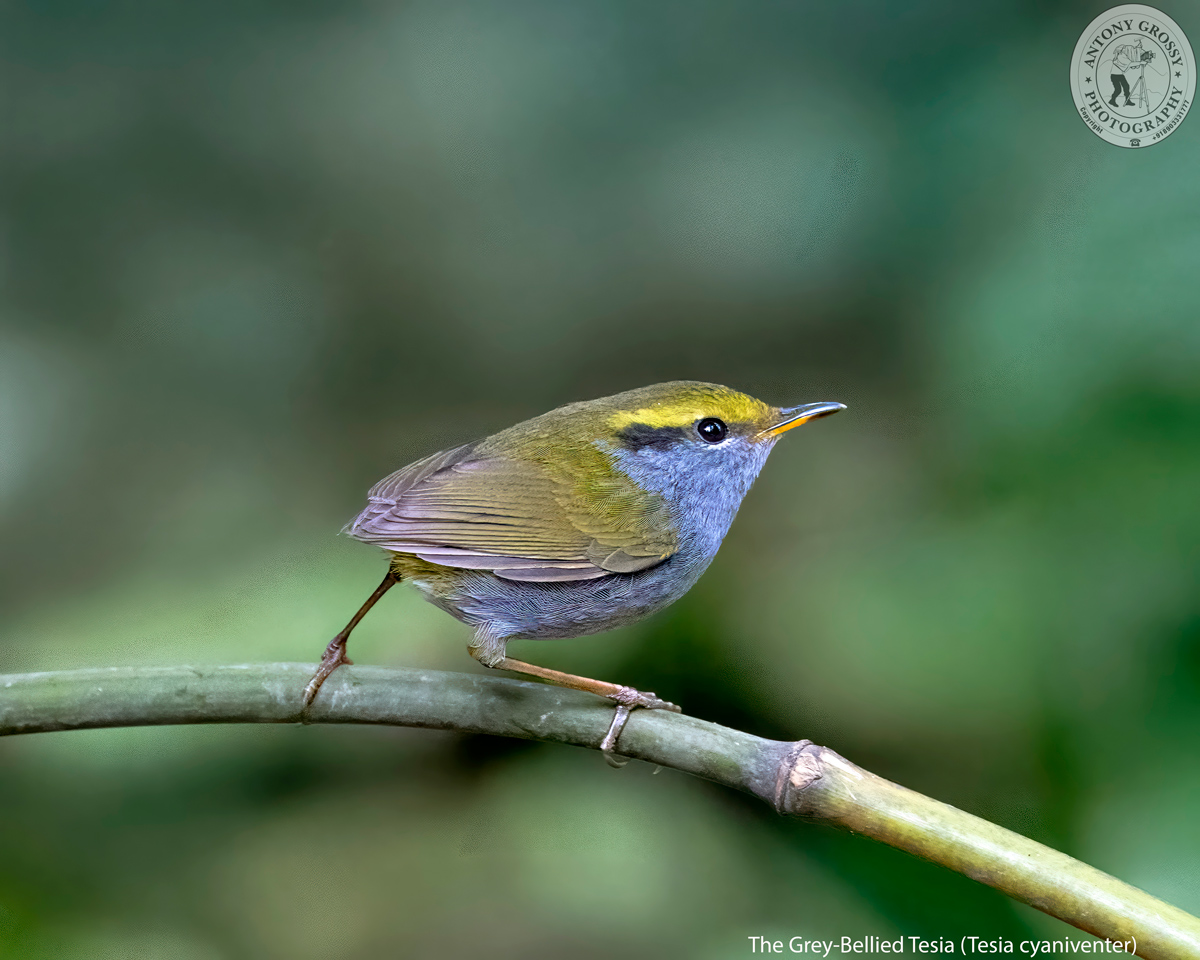

|
 |
| The Furtive Tailless Skulker of Thick Hilly Undergrowth – The Grey-Bellied Tesia |
| The Grey-Bellied Tesia is a long-legged and
short-tailed (almost tailless) yellowish-green grey bird. This tiny bird moves rapidly and unseen through dark, dense undergrowth like a pint-sized shadow. Yellowish-green above and grey below, with a black line extending through the eye below a pale yellowish eyebrow. The Slaty-Bellied Tesia is extremely similar, but has a brighter yellowish crown, darker grey underparts, and no pale eyebrow. . . . . . . . . . . . . .. .. …. ……. . .. … …… ………………………. ………….. ……………….. .. …. …. ……….. … …. ……….. … …. ………… ………….. ………… ………… ….. ………. …………. …….. ……………. …… …. …. ……….. … …. ……….. .. ………… ….. ………. …………. …….. …………. The Grey-Bellied Tesia is a small, upright and apparently tailless, ground-dwelling warbler. Being a very small bird, it measures just between 9 to 10 cm and weighs around 8 to 12 gms. It has bright olive-green upperparts, slightly paler crown, light green supercilium, broad black eyestripe; pale grey below, almost whitish on throat and centre of belly; iris dark; bill dark, basal two-thirds of lower mandible yellow; legs olive-brown to flesh-pink. Differs from very similar Slaty-Bellied Tesia mainly in having pale supercilium, less yellow crown, paler grey underparts. The Sexes are alike. Juvenile is dull olive-tinged warm brown above, supercilium and eyestripe duller than adult, drab olive below, paler or greyer on centre of throat and belly. . . . . . . . . . . . . .. .. …. ……. . .. … …… ………………………. ………….. ……………….. .. …. …. ……….. … …. ……….. … …. ………… ………….. ………… ………… ….. ………. …………. …….. ……………. …… …. …. ……….. … …. ……….. .. ………… ….. ………. …………. …….. …………. It is found in Bangladesh, Bhutan, Cambodia, China, India, Laos, Myanmar, Nepal, Thailand, and Vietnam. Its natural habitat is subtropical or tropical moist montane forest. It breeds in mid- to high-elevation forest, sometimes descending into lower foothills in the winter. Forages in dense undergrowth of broadleaf forest, principally in ferns, nettles, dwarf bamboo in moist valleys, wet ravines or near streams; between 1500 mtr and 2550 mtr, mostly above 1800 mtr. In non-breeding season occurs in broadleaf and secondary forest at lower altitudes, down to 60 mtr. It is an Altitudinal migrant, making post-breeding descent to lower elevations. Winter visitor to North Assam (NE India). . . . . . . . . . . . . .. .. …. ……. . .. … …… ………………………. ………….. ……………….. .. …. …. ……….. … …. ……….. … …. ………… ………….. ………… ………… ….. ………. …………. …….. ……………. …… …. …. ……….. … …. ……….. .. ………… ….. ………. …………. …….. …………. The Grey-Bellied Tesia feeds on small invertebrates, particularly ants and spiders, recorded. Very active, and appears to be ceaselessly on the move. Forages on ground and in vegetation, occasionally up to 6 mtr from ground. In non-breeding season may join mixed-species foraging flocks. . . . . . . . . . . . . .. .. …. ……. . .. … …… ………………………. ………….. ……………….. .. …. …. ……….. … …. ……….. … …. ………… ………….. ………… ………… ….. ………. …………. …….. ……………. …… …. …. ……….. … …. ……….. .. ………… ….. ………. …………. …….. …………. Its Song is a few clear, high, bell-like notes followed by a brief sputtering explosion of lower notes. Has surprisingly loud, rattling trrrrrk call. Song, mostly in AprMay, a series of short, loud and slurred phrases introduced with a few individual high-pitched notes, ji ji ju ju ju-chewit, ji juwiiwi, ji ji jiwi-jui, slower than that of Slaty-Bellied Tesia and lacking latters explosive and tuneless jumble of notes. ………. ………….. ………… ………… ….. ………. …… ………….. ………… ………… ….. ………………….. … ………… ….. ………. …… ………….. ………… ………… …. … … …… ………….. ………… ………… ….. ………………….. … ………… ….. ………. …… ………….. ………… ………… …. … ……………. …… ……………. ………… ….. ……………………………. …. ….. …… ………….. ………… ………… …. … ……………. …… ………….. …. …. … .. ……….. .. …………………. …. …………………….. Description Credit Birds of the World (The Cornell Lab), Oiseaux, Birda, Animalia, Nepal Desk, Ogaclicks, Birds of India | Bird World, Bird Count India & Wiki. |
  |
|
|






































































































































































































































































































































































































































































































































































































































































